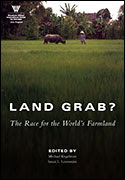-
Land Grab: Sacrificing the Environment for Food Security
January 27, 2010 By Wilson Center Staff According to the United Nations, 74 million acres of farmland in the developing world were acquired by foreign governments and investors over the first half of 2009 – an amount equal to half of Europe’s farmland.
According to the United Nations, 74 million acres of farmland in the developing world were acquired by foreign governments and investors over the first half of 2009 – an amount equal to half of Europe’s farmland.Land Grab? The Race for the World’s Farmland, a new book edited by Michael Kugelman and Susan L. Levenstein of the Wilson Center’s Asia Program, brings together international organizations, farmers, and agricultural investors to discuss this new phase of the world food crisis.
The book, which grew out of a May 2009 conference (webcast), includes regional case studies from Africa, Asia, and Europe/Former Soviet Union, as well as recommendations for farmland investors, host nations, and the international community.
“So long as the global race for farmland continues, the assault on the environment will as well – with troubling implications for food security,” Kugelman and Levenstein opine in World Politics Review:
Food-importing nations, with memories of the skyrocketing global food costs and supply shortages of 2008 still fresh, are increasingly fearful about the volatility of world commodities markets. Given their rising populations and disappearing arable land, such countries have good reason to be afraid. As a result, some food importers, particularly in the Persian Gulf and East Asia<, are now foregoing imports altogether and instead investing in foreign farmland to use for food production. They are joined by private agri-business firms, which perceive farmland as a wise investment in a food-insecure era.
Meanwhile, nations whose land is targeted, many of them dependent on international food aid, are desperate for agricultural investment. Though blessed with arable land, their farm yields are flat and their agricultural sectors flagging. Heavy doses of foreign capital, they reason, will enhance farming technology, improve crop yields, and ultimately end hunger. Although these hoped-for effects are not guaranteed, many governments in these countries welcome foreign interest in their land, and actively seek out prospective investors by dangling tempting tax incentives. Pakistan has even offered a 100,000-strong security force dedicated to protecting such investments.
This all portends an environmental nightmare. The prime targets of farmland investment – Central Africa, Southeast Asia, and South America – are home to most of the world’s remaining tropical rainforests. Industrial agriculture could fell considerable areas of this forest land and release vast quantities of carbon into the atmosphere. The world’s largest tropical rainforest, the Amazon, is particularly vulnerable. Land investors are increasingly turning their attention to South America, a region boasting a slew of tantalizing qualities, including nutrient-rich soil, water-laden farmland, and ample land for rain-fed crop production.
 A Publication of the Stimson Center.
A Publication of the Stimson Center.

 According to the United Nations, 74 million acres of farmland in the developing world were acquired by foreign governments and investors over the first half of 2009 – an amount equal to half of Europe’s farmland.
According to the United Nations, 74 million acres of farmland in the developing world were acquired by foreign governments and investors over the first half of 2009 – an amount equal to half of Europe’s farmland.

